MENU
The Electronic Scholarly Publishing Project: Providing access to classic scientific papers and other scholarly materials, since 1993. More About: ESP | OUR CONTENT | THIS WEBSITE | WHAT'S NEW | WHAT'S HOT
Comparative Timelines
The ESP Timeline (one of the site's most popular features) has been completely updated to allow the user to select (using the timeline controls above each column) different topics for the left and right sides of the display.
Select:
New Left Column
New Left Column
Dates
Decade
New Right Column
New Right Column
Jupiter Hammon of Long Island, New York, publishes a book of poetry. This is believed to be the first volume written and published by an African-American
New Jersey prohibits the enlistment of slaves in the militia without their master's permission.
 King George III ascends the English throne.
King George III ascends the English throne.
Giovanni Arduino proposes a naming system for geologic strata, in order of oldest to youngest: Primary: lacking fossils; Secondary: tilted with fossils; Tertiary: horizontal with fossils; Quaternary: sands and gravels overlying Tertiary strata. Although he does not relate these systems to scripture, many people will interpret them in terms of biblical events.
 Photometria by German physicist Johann Lambert is an investigation of light reflections from planets, introducing the term ALBEDO (whiteness) for the differing reflectivities of planetary bodies.
Photometria by German physicist Johann Lambert is an investigation of light reflections from planets, introducing the term ALBEDO (whiteness) for the differing reflectivities of planetary bodies.
 In experiments with primitive apparatus, Daniel Bernoulli decides that the electrical force obeys an inverse square law similar to that of gravity.
In experiments with primitive apparatus, Daniel Bernoulli decides that the electrical force obeys an inverse square law similar to that of gravity.
1760
 Joseph Gottlieb Kölreuter'S Vorläufige nachricht von einigen das geschlecht der pflantzen betreffende versuche and beobachtungen describes his research in heredity in plants.
Joseph Gottlieb Kölreuter'S Vorläufige nachricht von einigen das geschlecht der pflantzen betreffende versuche and beobachtungen describes his research in heredity in plants.
The Swiss physicist Johann Heinrich Lambert supports Wright and Kant s hierarchical universe and nebular hypothesis, and also hypothesizes that the stars near the Sun are part of a group which travel together through the Milky Way, and that there are many such groupings or star systems throughout the galaxy.
 Joseph Black discovers latent heat by finding that ice, when melting, absorbs heat without changing in temperature. Later he measures the latent heat of steam — that is, the heat required to keep water boiling without raising its temperature.
Joseph Black discovers latent heat by finding that ice, when melting, absorbs heat without changing in temperature. Later he measures the latent heat of steam — that is, the heat required to keep water boiling without raising its temperature.
1761
Jean-Baptiste Robinet's five-volume De la nature claims that organic species form a linear scale of progress, without gaps.
 Between 1761 and 1766, Joseph Gottlieb Kölreuter (Germany) demonstrates that hybrid offspring receive traits from both parents (pollen and ovule transmit genetic information), and are intermediate in most traits. First scientific hybrid produced (tobacco). Demonstrates the identity of reciprocal crosses. Notes hybrid vigor, segregation of offspring (parental and non-parental types) from a hybrid.
Between 1761 and 1766, Joseph Gottlieb Kölreuter (Germany) demonstrates that hybrid offspring receive traits from both parents (pollen and ovule transmit genetic information), and are intermediate in most traits. First scientific hybrid produced (tobacco). Demonstrates the identity of reciprocal crosses. Notes hybrid vigor, segregation of offspring (parental and non-parental types) from a hybrid.
 English poet, playwright, and novelist Oliver Goldsmith's Letters from a Citizen of the World is published, a collection of satirical essays on Britain from the point of view of a fictitious Chinese visitor.
English poet, playwright, and novelist Oliver Goldsmith's Letters from a Citizen of the World is published, a collection of satirical essays on Britain from the point of view of a fictitious Chinese visitor.
 French philosopher Jean-Jacques Rousseau writes a philosophical treatise on government and the populace, The Social Contract.
French philosopher Jean-Jacques Rousseau writes a philosophical treatise on government and the populace, The Social Contract.
 Austrian composer Wolfgang Amadeus Mozart, age 6, tours Europe as a musical prodigy.
Austrian composer Wolfgang Amadeus Mozart, age 6, tours Europe as a musical prodigy.
Virginia restricts voting rights to white men.
 Catherine the Great becomes Empress of all the Russias after death of her husband.
Catherine the Great becomes Empress of all the Russias after death of her husband.
George III purchases the Paper Museum of Cassiano Dal Pozzo, a 17th- century patron of arts and sciences. Preserved by the Albani family, this "museum" contains more than 7,000 science illustrations, including highly accurate depictions from the Lincean Academy that will prove invaluable to later science historians.
1762
 Charles Bonnet's Considerations sur les corps organisées gives his theory of "preformation" — the idea that each creature is already preformed in miniature in the egg, and that the egg contains all future generations in even smaller scale, ad infinitum.
Charles Bonnet's Considerations sur les corps organisées gives his theory of "preformation" — the idea that each creature is already preformed in miniature in the egg, and that the egg contains all future generations in even smaller scale, ad infinitum.
On May 16, English critic and writer Samuel Johnson meets the young Scotsman James Boswell, who will become his biographer.
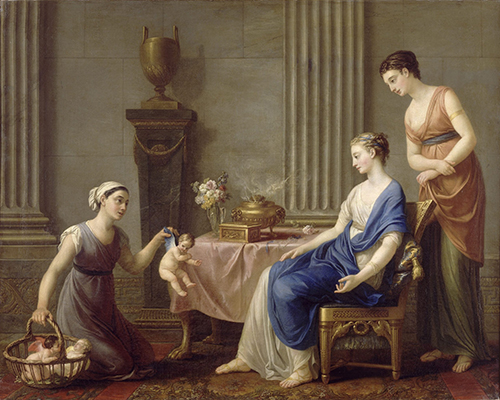 Painting by Joseph-Marie Vien: The Cupid Seller depicts a business transaction — the offer for sale of several wriggling cupids. The customers seem unimpressed.
Painting by Joseph-Marie Vien: The Cupid Seller depicts a business transaction — the offer for sale of several wriggling cupids. The customers seem unimpressed.
Charles Mason and Jeremiah Dixon begin surveying Mason-Dixon Line between Pennsylvania and Maryland.
 Chief Pontiac leads a Native American rebellion against British settlers in and around Detroit.
Chief Pontiac leads a Native American rebellion against British settlers in and around Detroit.
The French Indian War ends with the Treaty of Paris surrendering Canada to England.
1763
(no entry for this year)
 Austrian composer Wolfgang Amadeus Mozart, age eight, writes his first symphony.
Austrian composer Wolfgang Amadeus Mozart, age eight, writes his first symphony.
 German archaeologist and critic Johann Winckelmann publishes his History of Ancient Art Among the Greeks, the first book to include the phrase "history of art" in the title.
German archaeologist and critic Johann Winckelmann publishes his History of Ancient Art Among the Greeks, the first book to include the phrase "history of art" in the title.
1764
(no entry for this year)
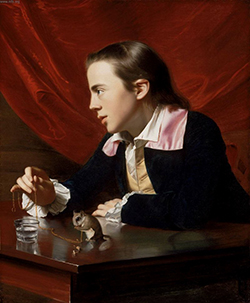 Painting by John Singleton Copley: The Boy with a Squirrel, a portrait highly praised when exhibited in London. The subject is Copley's half-brother, Henry Pelham, seated at a table and playing with a pet squirrel. This picture, which made the young Boston painter a Fellow of the Society of Artists of Great Britain, by vote of September 3, 1766, had been painted the preceding year
Painting by John Singleton Copley: The Boy with a Squirrel, a portrait highly praised when exhibited in London. The subject is Copley's half-brother, Henry Pelham, seated at a table and playing with a pet squirrel. This picture, which made the young Boston painter a Fellow of the Society of Artists of Great Britain, by vote of September 3, 1766, had been painted the preceding year
Britain enacts Quartering Act, requiring colonists to provide temporary housing to British soldiers.
Stamp Act passed; this is the first direct British tax on colonists.
 Leonhard Euler gives a general treatment of the motion of rigid bodies, including the precession and nutation of earth, in Theoria motus corporum solidorum seu rigidorum (Theory of the motion of solid and rigid bodies).
Leonhard Euler gives a general treatment of the motion of rigid bodies, including the precession and nutation of earth, in Theoria motus corporum solidorum seu rigidorum (Theory of the motion of solid and rigid bodies).
1765
 Italian biologist Lazzaro Spallanzani suggests preserving food by sealing it in containers that do not permit air to penetrate.
Italian biologist Lazzaro Spallanzani suggests preserving food by sealing it in containers that do not permit air to penetrate.
Britain repeals the Stamp Act.
 Horace-Bénédict de Saussure invents the electrometer, a device for measuring the electric potential by means of the attraction or repulsion of charged bodies.
Horace-Bénédict de Saussure invents the electrometer, a device for measuring the electric potential by means of the attraction or repulsion of charged bodies.
 Bifocal spectacles are invented by Benjamin Franklin.
Bifocal spectacles are invented by Benjamin Franklin.
First fire escape patented, consisting of a wicker basket on a pulley and chain.
1766
 Albrecht von Haller is the first to show that nerves stimulate muscles to contract and that all nerves lead to the spinal cord and the brain.
Albrecht von Haller is the first to show that nerves stimulate muscles to contract and that all nerves lead to the spinal cord and the brain.
Mozart's opera "Apollo et Hyacinthus," premieres in Salzburg.
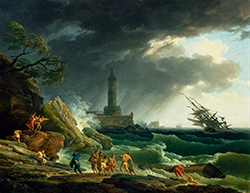 Painting by Claude Joseph Vernet: A Storm on a Mediterranean Coast. Perhaps no painter of landscapes or sea-pieces has ever made the human figure so completely a part of the scene depicted or so important a factor in his design. In this respect he was heavily influenced by Giovanni Paolo Panini, whom he probably met and worked with in Rome. Vernet's work draws on natural themes, but in a way that is neither sentimental or emotive. The overall effect of his style is wholly decorative.
Painting by Claude Joseph Vernet: A Storm on a Mediterranean Coast. Perhaps no painter of landscapes or sea-pieces has ever made the human figure so completely a part of the scene depicted or so important a factor in his design. In this respect he was heavily influenced by Giovanni Paolo Panini, whom he probably met and worked with in Rome. Vernet's work draws on natural themes, but in a way that is neither sentimental or emotive. The overall effect of his style is wholly decorative.
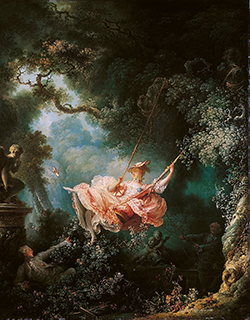 Painting by Jean-Honor Fragonard: The Swing (French: L'Escarpolette), also known as The Happy Accidents of the Swing (French: Les Hasards heureux de l'escarpolette, the original title), is an 18th-century oil painting in the Wallace Collection in London. It is considered to be one of the masterpieces of the rococo era, and is Fragonard's best known work. From a contemporary perspective, it would be hard to imagine a more frilly piece of trivia.
Painting by Jean-Honor Fragonard: The Swing (French: L'Escarpolette), also known as The Happy Accidents of the Swing (French: Les Hasards heureux de l'escarpolette, the original title), is an 18th-century oil painting in the Wallace Collection in London. It is considered to be one of the masterpieces of the rococo era, and is Fragonard's best known work. From a contemporary perspective, it would be hard to imagine a more frilly piece of trivia.
Britain passes Townshend Revenue Act levying taxes on America.
The Virginia House of Burgess boycotts the British slave trade in protest of the Townsend Acts. Georgia and the Carolinas follow suit.
1767
Benjamin Franklin writes a thank-you letter to a wealthy Irish trader for a box of proboscidian "tusks and grinders." Franklin believes the remains belong to elephants but makes astute observations about how their climate must have differed from the present.
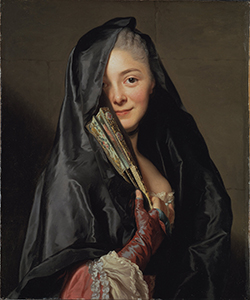 Painting by Alexander Roslin: The Lady with the Veil is one of the Swedish National Museum of Fine Arts' best loved paintings. The woman in the portrait is partially hidden by a black silk veil. Beneath the veil she is dressed for a special occasion in white lace and pink silk. During the 18th century, theatre was an important part of the life of the upper classes. Dressing up, disguising oneself and playing dramatic roles was a common pastime. The Lady with the Veil shows how one could dress up — la bolonaise — in the style of Bologna.
Painting by Alexander Roslin: The Lady with the Veil is one of the Swedish National Museum of Fine Arts' best loved paintings. The woman in the portrait is partially hidden by a black silk veil. Beneath the veil she is dressed for a special occasion in white lace and pink silk. During the 18th century, theatre was an important part of the life of the upper classes. Dressing up, disguising oneself and playing dramatic roles was a common pastime. The Lady with the Veil shows how one could dress up — la bolonaise — in the style of Bologna.
 Britain's Capt. James Cook begins exploring the Pacific, putting ashore in such places as New Zealand and Australia.
Britain's Capt. James Cook begins exploring the Pacific, putting ashore in such places as New Zealand and Australia.
James Cook sets sail on the Endeavour bound for the South Pacific. Accompanying Cook is naturalist Joseph Banks, who will collect tens of thousands of plant and animal specimens and initiate the exchange of flora and fauna between Europe, the Americas and the South Seas.
1768
 Lazzaro Spallanzani's Prodromo d'un ouvrage sur les reproductions animales (Foreword to a work on animal reproduction) tells of his demonstration that spontaneous generation of animals does not take place in tightly closed bottles that have been boiled for more than 30 minutes.
Lazzaro Spallanzani's Prodromo d'un ouvrage sur les reproductions animales (Foreword to a work on animal reproduction) tells of his demonstration that spontaneous generation of animals does not take place in tightly closed bottles that have been boiled for more than 30 minutes.
 Caspar Friedrich Wolff's De formatione intestinarum establishes principles of the formation of organs in embryos.
Caspar Friedrich Wolff's De formatione intestinarum establishes principles of the formation of organs in embryos.
 Father Junipero Serra founds Mission San Diego, first mission in California.
Father Junipero Serra founds Mission San Diego, first mission in California.
 John Robison measures the repulsion between two charged bodies and shows that this force is inversely proportional to the distance between the two bodies.
John Robison measures the repulsion between two charged bodies and shows that this force is inversely proportional to the distance between the two bodies.
 James Watt patents the modern steam engine, which finds wide use in manufacturing. It is an early milestone of the Industrial Revolution.
James Watt patents the modern steam engine, which finds wide use in manufacturing. It is an early milestone of the Industrial Revolution.
1769
 Charles Bonnet's Philosophical palingenesis, or ideas on the past and future states of living beings contains his view that the females of every species contain the germs of all future generations.
Charles Bonnet's Philosophical palingenesis, or ideas on the past and future states of living beings contains his view that the females of every species contain the germs of all future generations.
ESP Quick Facts
ESP Origins
In the early 1990's, Robert Robbins was a faculty member at Johns Hopkins, where he directed the informatics core of GDB — the human gene-mapping database of the international human genome project. To share papers with colleagues around the world, he set up a small paper-sharing section on his personal web page. This small project evolved into The Electronic Scholarly Publishing Project.
ESP Support
In 1995, Robbins became the VP/IT of the Fred Hutchinson Cancer Research Center in Seattle, WA. Soon after arriving in Seattle, Robbins secured funding, through the ELSI component of the US Human Genome Project, to create the original ESP.ORG web site, with the formal goal of providing free, world-wide access to the literature of classical genetics.
ESP Rationale
Although the methods of molecular biology can seem almost magical to the uninitiated, the original techniques of classical genetics are readily appreciated by one and all: cross individuals that differ in some inherited trait, collect all of the progeny, score their attributes, and propose mechanisms to explain the patterns of inheritance observed.
ESP Goal
In reading the early works of classical genetics, one is drawn, almost inexorably, into ever more complex models, until molecular explanations begin to seem both necessary and natural. At that point, the tools for understanding genome research are at hand. Assisting readers reach this point was the original goal of The Electronic Scholarly Publishing Project.
ESP Usage
Usage of the site grew rapidly and has remained high. Faculty began to use the site for their assigned readings. Other on-line publishers, ranging from The New York Times to Nature referenced ESP materials in their own publications. Nobel laureates (e.g., Joshua Lederberg) regularly used the site and even wrote to suggest changes and improvements.
ESP Content
When the site began, no journals were making their early content available in digital format. As a result, ESP was obliged to digitize classic literature before it could be made available. For many important papers — such as Mendel's original paper or the first genetic map — ESP had to produce entirely new typeset versions of the works, if they were to be available in a high-quality format.
ESP Help
Early support from the DOE component of the Human Genome Project was critically important for getting the ESP project on a firm foundation. Since that funding ended (nearly 20 years ago), the project has been operated as a purely volunteer effort. Anyone wishing to assist in these efforts should send an email to Robbins.
ESP Plans
With the development of methods for adding typeset side notes to PDF files, the ESP project now plans to add annotated versions of some classical papers to its holdings. We also plan to add new reference and pedagogical material. We have already started providing regularly updated, comprehensive bibliographies to the ESP.ORG site.
ESP Picks from Around the Web (updated 06 MAR 2017 )
Old Science

Weird Science

Treating Disease with Fecal Transplantation
Fossils of miniature humans (hobbits) discovered in Indonesia

Dinosaur tail, complete with feathers, found preserved in amber.
Astronomy

Mysterious fast radio burst (FRB) detected in the distant universe.